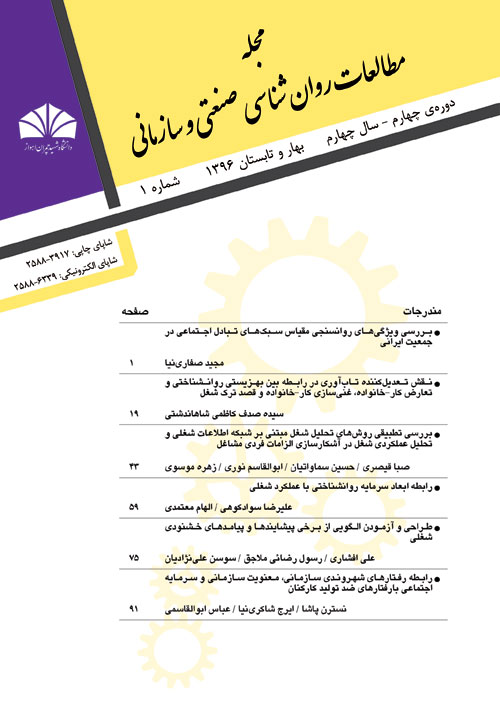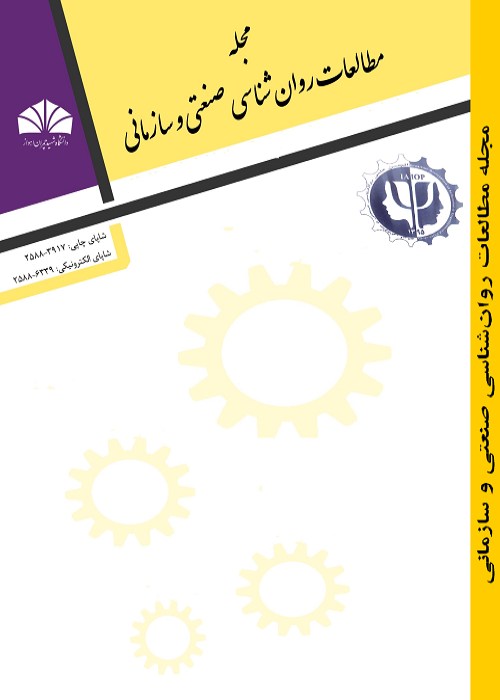فهرست مطالب

مجله مطالعات روان شناسی صنعتی و سازمانی
سال چهارم شماره 1 (بهار و تابستان 1396)
- تاریخ انتشار: 1396/05/30
- تعداد عناوین: 6
-
صفحات 1-18هدف پژوهش حاضر بررسی ویژگی های روانسنجی مقیاس سبک های تبادل اجتماعی در جمعیت ایرانی بوده است. جامعه آماری پژوهش شامل کلیه زنان و مردان شهر تهران بود. شرکت کنندگان در پژوهش 470 نفر از این جامعه بودند که که به روش تصادفی چندمرحله ای انتخاب شدند و به مقیاس سبک های تبادل اجتماعی لیپمن و همکاران، پاسخ دادند. برای بررسی پایایی این مقیاس از ضریب آلفای کرونباخ و جهت بررسی روایی آن از روایی محتوایی و روش های تحلیل عاملی اکتشافی و تاییدی استفاده شد. ضریب آلفای کرونباخ به دست آمده (83/0) حاکی از پایایی بالای مقیاس و نتایج تحلیل های عاملی اکتشافی نشان دهنده وجود پنج عامل انصاف، منفعت طلبی، فردگرایی، پیگیری و سرمایه گذاری افراطی با تغییر در برخی گویه های اصلی و حذف گویه های 5، 6، 11، 12، 26، 27، 30، 32، 36، 40، 44، 51 و 53 بود. همچنین، نتایج تحلیل عاملی تاییدی نشان دهنده برازش نسبتا خوب مدل 41 گویه ای بود. به علاوه، یافته های مربوط به هنجارسازی نشان داد که میانه نمرات انصاف، منفعت طلبی، فردگرایی، پیگیری و سرمایه گذاری افراطی در کل نمونه ایرانی به ترتیب برابر با 14، 32، 21، 27 و 13 می باشد.کلیدواژگان: ویژگی های روانسنجی، تبادل اجتماعی، انصاف، منفعت طلبی، فردگرایی، پیگیری، سرمایه گذاری افراطی
-
صفحات 19-42هدف پژوهش حاضر بررسی نقش تعدیل کننده تاب آوری در رابطه بین بهزیستی روانشناختی با تعارض کار-خانواده، غنی سازی کار-خانواده و قصد ترک شغل بود. نمونه این پژوهش شامل 363 نفر (222 مرد و 141 زن) از کارکنان شرکت ملی حفاری ایران بود که به روش تصادفی ساده انتخاب شدند. برای سنجش متغیرهای مورد مطالعه از پرسشنامه های تعارض کار-خانواده، غنی سازی کار-خانواده، تاب آوری ، قصد ترک شغل، خشنودی شغلی، خشنودی خانوادگی و سلامت روان استفاده گردید. جهت تحلیل داده ها از ضریب همبستگی پیرسون و تحلیل رگرسیون سلسه مراتبی تعدیلی استفاده شد. نتایج حاصل از پژوهش حاضر نشان داد که بهزیستی روانشناختی رابطه منفی و معنی دار با تعارض کار-خانواده و قصد ترک شغل دارد و همچنین بهزیستی روانشناختی با غنی سازی کار-خانواده رابطه مثبت و معنی دار دارد. یافته های تحلیل رگرسیون تعدیلی، نقش تعدیل گر تاب آوری را در این روابط مورد تایید قرار دادند.کلیدواژگان: بهزیستی روانشناختی، تعارض کار-خانواده، غنی سازی کار-خانواده، قصد ترک شغل، تاب آوری
-
صفحات 43-58پژوهش حاضر با هدف شناسایی معیارهای فردمحور مرتبط با وظایف مجموعه ای از مشاغل و استفاده از آن ها به منظور تدوین سیستم ارزیابی عملکرد فرد محور انجام شد. جامعه آماری، تمام مشاغل موجود در شرکت توزیع برق استان اصفهان؛ شامل 98 شغل بود که به صورت تصادفی "واحد لوازم اندازه گیری" با 8 شغل به عنوان نمونه انتخاب گردید. در این پژوهش، مشاغل هدف با استفاده از روش تحلیل شغل مصاحبه ای مبتنی بر شبکه اطلاعات شغلی (اونت) شامل فهرستی از وظایف و ویژگی های فردی که به صورت کلی ارائه می شوند و روش تحلیل شغل کارکردی (اف جی ای) که به طور تفکیکی ویژگی های فردی مرتبط با هر وظیفه را مشخص می نماید، تحلیل شدند. تحلیل نتایج این پژوهش نشان می دهد که دو روش اونت و اف جی ای می توانند روش های مکمل مطلوبی برای تحلیل شغل باشند، با این وجود در صورت محدودیت زمان و هزینه و اهمیت مشاغل مورد بررسی پیشنهاد می شود که سازمان ها جهت دستیابی به نتایج مطلوب در خصوص تحلیل شغل و تعیین استانداردهای عملکردی فردمحور، برای مشاغل رده پایین سازمان از روش تحلیل شغل اونت و برای مشاغل رده بالا و دارای درجه اهمیت بالا از روش اف جی ای استفاده کنندکلیدواژگان: الزامات شغلی فردمحو، تحلیل شغل، تحلیل عملکردی شغل، شبکه اطلاعات شغلی
-
صفحات 59-74هدف پژوهش حاضر بررسی رابطه ابعاد سرمایه روانشناختی با عملکرد شغلی بود. جامعه آماری پژوهش را کلیه کارکنان نظامی شرکت کننده در دوره آموزشی عالی رسته ای تشکیل دادند که تعداد 76 نفر از آن ها به طور تصادفی ساده به عنوان اعضای نمونه انتخاب شدند. ابزار پژوهش شامل پرسشنامه های سرمایه روانشناختی لوتانز و پرسشنامه عملکرد شغلی پاترسون بودند. نتایج محاسبه ضرایب همبستگی ساده پیرسون نشان داد بین تمام ابعاد سرمایه روانشناختی با عملکرد شغلی رابطه مثبت و معناداری وجود دارد. نتایج تحلیل رگرسیون نشان داد که از میان ابعاد خودکارآمدی، امیدواری، تاب آوری، خوش بینی تنها تاب آوری توانست به طور معناداری عملکرد شغلی را پیش بینی کند. 8/15 درصد از واریانس عملکرد شغلی توسط تاب آوری تبیین شد.کلیدواژگان: سرمایه روانشناختی، عملکرد شغلی، خودکارآمدی، تاب آوری
-
صفحات 75-90هدف از انجام پژوهش حاضر بررسی پیشایندها (اشتیاق شغلی، سلامت سازمانی و فرهنگ سازمانی) و پیامدهای خشنودی شغلی (عملکرد شغلی و تعهد سازمانی) بود. جامعه آماری شامل کلیه معلمان شهر مراغه بود که از بین آن ها تعداد 330 نفر با روش نمونه گیری تصادفی چند مرحله ای به عنوان نمونه انتخاب شدند. ابزارهای استفاده شده در این پژوهش شامل پرسشنامه های خشنودی شغلی مینه سوتا، عملکرد شغلی معلمان پات، تعهد سازمانی می یر و آلن، سلامت سازمانی مدارس، فرهنگ سازمانی گلسر و همکاران و اشتیاق شغلی اترخت بودند. ارزیابی الگوی پیشنهادی از طریق الگویابی معادلات ساختاری (SEM) و با استفاده از نرم افزار SPSS-23 و AMOS-23 انجام گرفت. جهت آزمودن روابط واسطه ای در الگوی پیشنهادی از روش بوت استراپ استفاده شد. نتایج نشان دادند که الگوی پیشنهادی از برازش قابل قبولی برخوردار است.کلیدواژگان: اشتیاق شغلی، سلامت سازمانی، فرهنگ سازمانی، خشنودی شغلی، عملکرد شغلی، تعهد سازمانی
-
صفحات 91-111هدف پژوهش حاضر بررسی رابطه رفتارهای شهروندی سازمانی، معنویت سازمانی و سرمایه اجتماعی با رفتارهای ضد تولید کارکنان بود. جامعه آماری پژوهش شامل تمامی کارکنان کارخانه صنایع هفت الماس قزوین بود. از این جامعه 276 نفر به صورت در دسترس انتخاب و در پژوهش شرکت کردند. برای جمع آوری داده ها از پرسشنامه های رفتارهای ضد تولید بنت و رابینسون، معنویت سازمانی میلیمن و همکاران، رفتار شهروندی سازمانی پودساکف و همکاران و سرمایه اجتماعی سازمانی لادردال استفاده شد. داده ها با استفاده از ضریب همبستگی پیرسون و ضریب رگرسیون چندگانه تحلیل شد. نتایج تحلیل رگرسیون چندگانه نشان داد که تمامی متغیرهای پیش بین با رفتارهای ضد تولید کارکنان رابطه دارند و حدود 10 درصد از واریانس رفتارهای ضد تولید را پیش بینی می کنند.کلیدواژگان: رفتارهای شهروندی سازمانی، رفتارهای ضد تولید، سرمایه اجتماعی، معنویت سازمانی
-
Pages 1-18The aim of this research was to investigate psychometric characteristics of Social Exchange Styles Scale in Iranian population. Statistical population of this research included all women and men in Tehran. The participants were 470 of this population who were selected by multi-stage random sampling method. They responded to Social Exchange Styles Scale (Leybman et al.). For investigating the scale`s reliability, Cronbach`s alpha coefficient, and for valilidity, content validity and exploratory and confirmatory factor analysis were used.Cronbach`s alpha coefficient (0.83) showed that this scale has high reliability, and results of exploratory factor analysis showed five factors including fairness, benefit-seeking, individualism, tracking and overinvestment with changing in some main items and removing items 5, 6, 11, 12, 26, 27, 30, 32, 36, 40, 44, 51, and 53. Also, results of confirmatory factor analysis showed that 41-items model had relatively good fitness. In addition, results of normalization showed that median scores of fairness, benefit-seeking, individualism, tracking and overinvestment in whole of Iranian sample respectively were 14, 32, 21, 27, and 13.Keywords: psychometric characteristics, social exchange, fairness, benefit-seeking, individualism, tracking, overinvestment
-
Pages 19-42The purpose of this study was to investigate the moderating role of resiliency on the relationship of psychological well-being with work-family conflict, work-family enrichment and turnover intention. The participants of this study consisted of 363 employees of National Iranian Drilling Company (222 male & 141 female), who were selected by simple random sampling method. The instruments used in this study were Work-Family Conflict, Work-Family Enrichment, Resilience, Turnover Intention, Job Satisfaction, Family Satisfaction and General Health (GHQ-12) Questionnaires. Data was analyzed by Pearson correlation coefficients and moderated hierarchical regression analysis. The results showed that there was a significant negative relationship between psychological well-being and work-family conflict and turnover intention and there was a significant positive relationship between psychological well-being and work-family enrichment. Further, moderated regression analysis showed that resiliency moderated these relationships significantly.Keywords: psychological well-being, work-family conflict, work-family enrichment, turnover intention, resilience
-
Pages 43-58This study aimed to identify individual criteria associated with a set of job tasks and use them to develop individual-oriented appraisal system was conducted. Statistical population was all jobs in the Isfahan's electricity distribution company, including 98 jobs that in the qualitative study, "measuring instruments unit" accidentally was chosen by 8 jobs. In this study, analyzed target jobs using an interview-based job analysis upon Occupational Information Network (O * NET) including a list of tasks and individual characteristics which is provided as a whole and functional job analysis (FJA) which determines relation of each task with the individual characteristics. Analytical review of strengths and weaknesses of the methods used, indicate that the two methods FJA and O* NET can be appropriate complementary methods in order to develop Individual-oriented performance appraisal criteria, Thus, each of the referred methods has strengths that are well cover each other's weaknesses. However, if the time, cost and importance of jobs are restrict, is proposed that organizations to achieve optimal results in field of job analysis and determine individual-oriented appraisal standards use O * NET for low-level jobs and FJA for high-level and important jobs.Keywords: individual-oriented job requirements, job analysis, functional job analysis, occupational information network
-
Pages 59-74The purpose of this study was to investigate the relationship of psychological capital's dimensions with job performance. The statistical population included all military personnel participating in excellent classic course, of which 76 employees selected by simple random sampling method. The instruments were Lutanz's Psychological Capital Inventory and Paterson's job Performance Questionnaire. The results of Pearson simple correlation coefficient showed that there is a positive and significant relationship between all dimensions of psychological capital and job performance. The results of regression analysis showed that only resiliency could predict job performance. It explained 15.8 percent of job performance Variance.Keywords: psychological capital, job performance, self-efficacy, resiliency
-
Pages 75-90The aim of this study was designing and testing the antecedents (job engagement, organizational health and organizational culture) and the outcomes of job satisfaction (job performance and organizational commitment). The research population consisted of all teachers of Maragheh city. From this population, 330 teachers were selected through stratified random sampling method. Instruments used in this research were job satisfaction, job engagement, organizational health, organizational culture, organizational commitment and job performance questionnaires. The proposed model was tested through Structural Equation Modeling (SEM) and using the SPSS-23 and AMOS-23 softwares. For testing the indirect relationships, bootstrap procedure was used. The results of this study showed the acceptable fit of the model with the data.Keywords: job engagement, organizational health, organizational culture, job satisfaction, job performance
-
Pages 91-111The aim of this research was to investigate the relationship of organizational citizenship behaviors, organizational spirituality and social capital with employees' counterproductive behaviors. The statistical population consisted of all employees of Qazvin Haft Almas Manufacturing Factories. The research sample consisted of 276 employees of this population who were selected by convneince method. Instruments included Bennett & Robinson counterproductive, Milliman et al. organizational spirituality, Podsakoff et al. organizational citizenship behavior and Lauderdale social capital questionnaires. The data were analyzed using Pearson correlation coefficient and multiple regression analysis. The results of multiple regression analysis showed that organizational citizenship behaviors (12.2%), organizational spirituality (1%) and social capital (5%) explained the variance of counterproductive behaviorsKeywords: organizational citizenship behaviors, counterproductive behaviors, social capital, organizational spirituality


